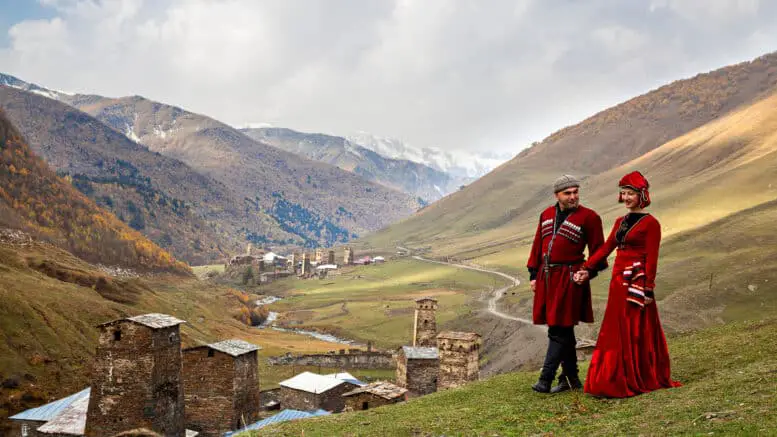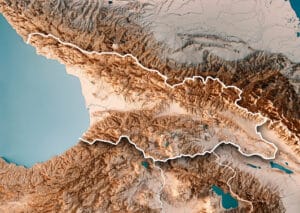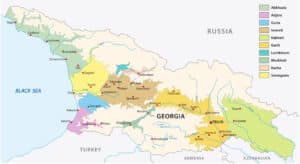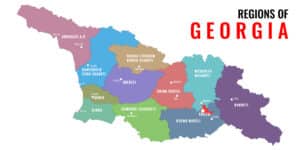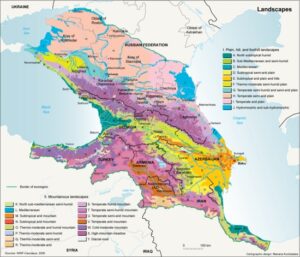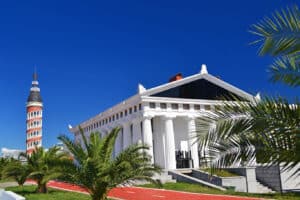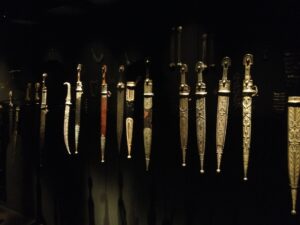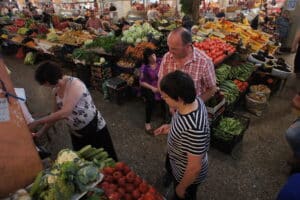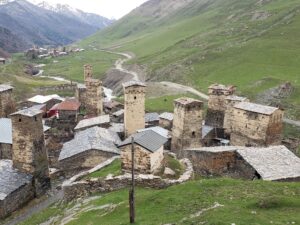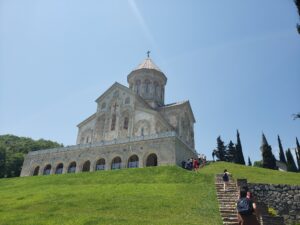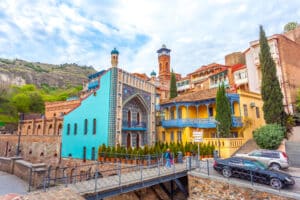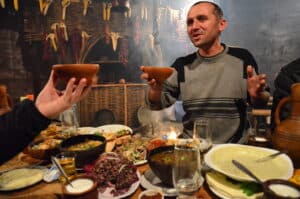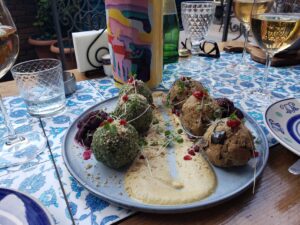What Georgia might lack in size it makes up for in personality. Over the millennia, the nation we now call Georgia has been part of empires ruled by Romans, Persians, Turks, and Russians. It has also been its own regional empire and myriad independent kingdoms. It was one of the first nations to officially adopt Christianity as a state religion, and, although ruled by others for centuries, Georgians have kept their own unique languages and alphabet, which is not related to any other language family or alphabet, and their own proud identity.
Today, Georgia sees its culture and future as more tied to Europe than any other area. More than anything, Georgia sees itself as independent and defined by a culture that values good food, wine, and conversation as well as boisterous traditional performance arts.
Geohistory and Historical Development
About the size of West Virginia, wedge-shaped Georgia features an agricultural heartland that opens to Black Sea beaches and ports to the west. There are glaciers and soaring mountains in the north. The foothills of the Lesser Caucasus range along parts of its southern border. This complex system of mountains has both protected Georgians, fostered incredible cultural diversity, and invited invasion from empires seeking their protection and resources.
- A map showing Georgia’s rugged topography. Its central valley opens to a wide agricultural heartland on the Black Sea and, connected with Azerbaijan, has also been a trade route connecting the Black and Caspian Seas.
- A map showing Georgia’s major rivers and wine producing regions.
Evidence of settled crop and meat production dates to about 6000 BCE and wine production from about 4000. The Hittites and the Assyrians, often cited as precursors of Western civilization, raided the land to extract tributes of metals and food to fuel their armies. This helped force the various tribes, separated by the mountains, to unite into larger fighting forces better able to resist the invasions.
By the 8th century, the independent kingdom of Colchis had consolidated power in the region and prospered by actively trading with Greeks in metals, wine, and honey, absorbing some elements of Greek culture in the process.
In the 6th century, Colchis was incorporated into the Persian Achaemenid Empire. However, prosperity continued as the empire opened new markets. Persian influence on the Georgian language as well as its social structure, arts, and literature was significant. The empire also spread Zoorastrianism there.
When the empire fell, Colchis was again independent as was Iberia, another successor kingdom to modern Georgia, to its south. These two would see influence from both Persians and Romans for many years, occasionally being absorbed by one or the other.
In many lands where Zoroastrianism spread, Christianity followed. The Apostle Andrew traveled the region widely and was likely the first to bring the new religion to what was then Iberia. In the 4th Century, Iberia became the world’s second officially Christian state, after Armenia, which also often dominated it politically at the time.
The Caucasus then suffered multiple invasions from the Arabs, Byzantines, and Eurasian nomadic tribes. Iberia was dominated by the Arabs, although it largely kept its language and religion. What had been the territory of Colchis eventually formed into an independent Kingdom of Abkhazia.
When the Arab empire fell, the Bagratids rose to power, eventually uniting Abkhazia and Iberia and expanding to unite much of the Caucasus under a new Kingdom of Georgia. Despite pressure from the Seljuk Turks and Romans, the kingdom held and experienced a golden age, which stretched from King David in the early 1000s to his great granddaughter, Queen Tamar, through the early 1200s. Under Tamar, Georgia expanded still further into a powerful and culturally great Georgian Empire.
- Map of the greatest extent of the Georgian Empire, ca. 1200. Screen grab from Epimetheus.
- Current administrative regions of Georgia. The names and locations all roughly align with smaller kingdoms that once existed before uniting into a single country. Note that Abkhazia and South Ossetia, which are de-facto independent breakaway states, are also shown.
Shortly after Tamar’s death, the Mongols invaded. The Georgian Empire shrank and eventually fractured into small kingdoms that today roughly form Georgia’s interior provinces. Without unity, the kingdoms were dominated by the Turkic Ottomans in the west and Persian empires to the east. Due in part to their protective mountain ranges and political maneuvering, the local kingdoms kept some autonomy, including their language and religion, Christianity.
This situation remained until the 19th century, when Russia absorbed the Caucasus as a defensive barrier and colonial addition to their economy.
Although relatively recent, Russian rule has substantially affected modern Georgia, particularly under the Soviets who collectivized agriculture, pushed industrialization, and spread the Russian language and culture. Georgian political institutions were impacted and ideas of nationalism were spread. Perhaps ironically, this eventually helped to unite Georgia enough to throw off Soviet rule, but also helped divide it to the extent that it would almost immediately fall into a Civil War shortly thereafter.
Economy – Agriculture
Georgia’s many mountains and valleys form a climatically diverse ecosystem, with many microclimates supporting biodiversity. A vast array of plants can thrive across Georgia although only 4.5% of the country is suitable for intensive crop agriculture. Wheat increasingly dominates this. Corn is also grown, but falling in production. Many subsistence farms grow high value crops such as grapes, peaches, tangerines, apricots, and nuts.
- Georgia shown within the wider Caucasus region. Environmentally and culturally, the area extends into Russia, Turkey, and Iran.
- The diverse climactic regions of the wider Caucasus area are created by the complex mountain ranges. Map from WWF-Caucasus, design Manana Kurtubadze
A major challenge to Georgian agriculture is the post-Soviet legacy. In the 1990s, agricultural land was privatized primarily as a way to support the population in a time of extreme hardship. Very small parcels, most between one and 2.5 acres, were given to all citizens. Some moved to these plots to take up subsistence agriculture in the collapsing economy. This process was not well documented and today, to sell the land further, it is necessary to pay for a survey to be taken and additional state fees. Many do not have the resources for this and thus cannot sell the land they work. Further, there is not a sufficient state-wide database of lands for potential buyers to use to find lands suitable for investment.
Georgian agriculture has failed to take advantage of economies of scale and has been squeezed in the global economy. Agriculture in Georgia, including livestock and dairy production, is declining in diversity, land use, and overall production. Despite this, agriculture continues to absorb 40% of the labor force while only contributing about 7% of GDP. Government programs have focused on subsidizing farmers rather than addressing the sector’s core challenges and inefficiencies.
Economy – Minerals and Industry
Georgia’s mountains hold large deposits of copper, manganese, and iron as well as coal, gold, and marble. Georgia produces large amounts of steel, chemicals, and fertilizers in part using local mineral deposits. Cars are produced from Georgian steel and electrical appliances are made in part with Georgian copper. Mineral extraction has been widely privatized and deregulated in recent years and is a growing contributor to the Georgian economy. Worker accidents and deaths are also rising swiftly.
Despite falling agricultural production, food and beverage export values have been rising thanks to increased food processing activities. Wine, mineral water, and nuts are among Georgia’s top exports.
Economy – Energy, Transport, and Potential Growth
Hydropower accounts for 75% of electricity production with the remainder produced by natural gas and wind. Gasoline and diesel are imported from Azerbaijan and Turkmenistan. Locally sourced coal is used in industry.
- The warm, tropical climate of Batumi, Georgia has long drawn tourists.
- Traditional Svaneti daggers at the Svaneti Museum. The Caucasus are rich in metals and the people here have had a long tradition of metal working.
- A traditional market in Georgia selling produce.
Animosities among Turkey, Azerbaijan, and Armenia have made Georgia a natural hub between Turkey and Azerbaijan and the only viable export route for Armenia. Georgia has negligible hydrocarbon deposits, but receives most of what it needs by charging a percentage of what it transports for other countries. Georgian ports on the Black Sea give it access to world markets, including for hydrocarbon export and import.
Tourism is the fastest growing and most visible economic sector. Batumi’s beaches and resorts have benefited most, and the city has grown from Georgia’s fourth to second largest.
Given Georgia’s connectivity and mineral wealth, its options for growth are wide. Corruption and the fact that so many Georgians are employed in low-paying agricultural pursuits are two oft-cited reasons for why Georgia doesn’t grow faster.
Society and Demographics
In Georgian, Georgia is actually called Sakartvelo, “the land where people speak Kartvelian”; in other words, where people speak Georgian. However, there is not just one Kartvelian language and dialect, but rather several. Although most demographic breakdowns will report that Georgia is about 85% Georgian, the various “Georgians” will also identify as a smaller subgroup such as Svans, Gurians, Adjarians, Mingrelians, and Imeretians, which has its own language or dialect, history, culture, and identity.
This 85% of the population that is identified as “Georgian” roughly overlaps with individuals who profess Georgian Orthodox Christianity, another major unifying element for the diverse Georgian population.
Outside of the Kartvellian-speaking, Orthodox majority, Azerbaijanis (6%) and Armenians (4%) are the main ethnic minorities. The Abkhaz and Ossetians, the titular ethnic groups of Georgia’s two breakaway provinces, would be smaller minorities if they were counted in Georgia’s official population (Georgia’s official census does not include them).
Russians, once 6% of the population in 1989, now number just .7%, as the fourth largest official ethnic group. Particularly since Russia’s mobilization drive, however, Georgia has seen a significant number of immigrants from Russia, raising this number by perhaps as much as an additional 1% of the population. An estimated additional 30,000 Ukrainians have also relocated to Georgia as refugees since the start of 2022.
Georgia is a popular destination for Russians because Russian remains a very strong international language spoken by many Georgians. This legacy of Russian and Soviet rule is strongest in major cities and among older populations.
- Svan homes in Svaneti, Georgia doubled as defensive towers.
- The Church of St. George inside the Bodbe Monastery of St. Nino in Kakheti, Georgia, was built in the 9th Century.
- Colorful, Persian-influenced architecture in Tbilisi, Georgia.
In terms of religion, Georgia was long ruled by Muslim empires but today only about 10% of the citizens in Georgia are Muslim. These are two main groups: the Laz, who speak a Kvartvelian language, but converted to Sunni Islam while they were ruled by the Ottomans, are concentrated around the port city of Batumi, and the Azerbaijani Shias, concentrated at the Azerbaijani border.
There is also a very small but historically important population of Jews, mostly in Tbilisi, where there are two active synagogues and a Jewish museum.
Approximately 30% of Georgia’s 3.7 million people live in Tbilisi, the capital. Another 30% are spread between other urban areas. The remaining 40% live in rural areas. Many also live abroad and send money back home.
In the late twentieth-century, Georgia’s underdeveloped economy drove up immigration and drove down fertility rates. Today, this shrunken generation is now the main childrearing demographic group. Current fertility rates mean that further population decline is likely and the average age of Georgia’s population will continue to rise.
Briefly on Politics
Since the 1990s, most viable political parties in Georgia have been European-leaning and economically liberal. Elections thus focus on personalities rather than ideology or proposed policies. Two parties dominate: UNM, founded by former president Mikhail Saakashvili, and Georgian Dream, founded by billionaire Bidzina Ivanishvili.
Georgia’s two breakaway republics, South Ossetia and Abkhazia, gained de facto independence through civil wars in the 1990s, wars fought mostly over political and linguistic autonomy. (The titular populations do not speak Kartvelian languages). Georgia excludes them in state statistics, and they are not reported here. Returning the “lost territories” — about 20% of Georgia’s official territory — remains a central political issue.
The most trusted figure in Georgian public life is Patriarch Ilia II, who has led the Georgian Orthodox Church since 1977. The religious leader represents a strong social conservatism in Georgian politics and society that clashes sometimes with Georgia’s aspirations to join the much more socially liberal EU.
Regional Relations
Georgia is well integrated with Black Sea countries via regional organizations. Turkey is Georgia’s single largest trading partner. Turkey is also a driving force in the Organization of the Black Sea Economic Cooperation (BSEC) of which Georgia is a member.
Georgia is a founding member of GUAM, which unites it with Ukraine, Azerbaijan, and Moldova into an organization that seeks regional solutions and development. The grouping includes countries that have had issues with separatism and problematic relations with Russia.
Georgia and Ukraine have long had a special relationship, born initially from cultural contacts across the Black Sea, and later strengthened by a shared anti-Soviet experience.
- Female Georgian dancer will perform movements made to look like they are light, quick, and nearly floating.
- Male dancers perform quick actions that require strength and balance. The tradition costume is military and features vials for gunpowder across the breast.
- Georgian meals are often long and punctuated with toasts.
Other Foreign Relations
Georgia’s foreign relations are highly polarized. Nearly 90% of the population believes that Russia is a threat. The 2008 Russo-Georgian War lasted twelve days and ended with Russia recognizing Georgia’s two breakaway republics (Abkhazia and Southern Ossetia) as independent. At the same time, Russia is Georgia’s second largest trading partner, and Russian tourists are essential to Georgia’s tourism sector.
70% of Georgians consider the US to be Georgia’s most important ally. 55% consider the US Georgia’s most important economic partner, although the US ranks fourth among its trade partners. Georgia regularly contributes substantial troops to US-led wars. US companies have invested heavily in Georgia’s pipelines and ports. A US-Georgia Free Trade Agreement has been under negotiation for several years. Relations are currently streamlined via The US-Georgia Charter on Strategic Partnership.
More than 2/3 of Georgians support joining NATO. More than 75% of Georgians support joining the EU. EU financing has been instrumental in aiding the growth of Georgian businesses. If taken together, EU countries account for 23% of Georgia’s trade.
Georgians are increasingly going abroad to find work. Their remittances sent to their families back home now account for a rapidly rising 13% of GDP and are a source of income for about 20% of all Georgian families. Remittances mostly come from the EU (Greece and Italy in particular), Russia, and the US.
China is Georgia’s third largest trading partner. Most Georgians view China in neither a positive nor negative light. China has made some investments into Georgia, but relatively few compared to efforts made in other countries along its various “Belt and Road” infrastructure initiatives. This could be due to the fact that most Georgian infrastructure has been funded by western sources.
Cultural and Identity Markers
Language and religion are the most unifying Georgian cultural aspects. Other visually noticeable elements include traditions surrounding food. Georgian cuisine blends unique flavor combinations using the range of meats, beans, vegetables, fruits, herbs, and spices grown locally. It makes liberal use of distinctive flavors and textures, partly a result of their use of tarragon, walnut, pomegranate, and fresh cow’s milk cheese. Within the country, dishes have regional identity and regional variations, but it is, like language and religion, more a unifying element to Georgian than one that shows division.
- Adjarian khachapuri and wine make an excellent lunch.
- Pkhali is a distinctive salad made from vegetables, nuts, and herbs. It is often eaten spread on bread.
- Churchkhela is a Georgian candy made from concentrated fruit juice and nuts
It’s likely people who lived in Georgia thousands of years ago developed wine and winemaking. In fact, the Georgian word for wine is ღვინო, hvino, which is probably the source of words like wine, viniculture, vines in English. The traditional Georgian cross, itself a marker of identity and religion, is made from intertwined grape vines. Wine in Georgia draws from scores of grape varieties and produces wines totally unique to Georgia and fundamentally different from “traditional” wines like those produced in France, Italy, Spain, and the United States, in part because many Georgian wines are aged in terracotta amphorae called kvevri. The khantsi, or traditional Georgian drinking horn, usually made from a goat or ram’s horn, is still a symbolic part of Georgian wine culture.
The Georgian festive meals are called supra, and have exerted tremendous influence over regional celebratory meals. Dozens of room-temperature dishes, the consumption of drink, and various entertainments are managed by a toastmaker, called tamada in Georgian.
Georgian dance, music, and dress are a crucial part of Georgian identity. Georgian dance is related to Turkic and Circassian dancing and emphasizes precise, quick movements that often make the dancer appear to be floating or flying.
Traditional Georgian dress is related to that worn throughout the Caucasus and Turkey, and local versions are sources of national pride. For men, this is the chokha, a wool coat or tunic made for comfort and movement. The best known form is the military version, which features a row of bullet cases across the chest and is often paired with a scabbard and dagger. Women’s dresses, known as kartuli, are diverse, but generally feature a tight belt and bodice and cover the feet without dragging on the floor.
Simply knowing the depth and breadth of the culture is another important cultural marker. Georgia was a settled, powerful kingdom even in ancient times. Visited by the Apostles Simon and Andrew in the 1st century, it has been strongly Christian ever since. It has its own extant mythology, literature, written histories, epic poems, and more – going back centuries. The Georgians interacted with and respected the ancient Greeks, with whom they studied philosophy, sculpture, and more.
Many Georgian contributions to world culture, however, are today what we might call masked or muted. Notable contemporary artists and statesmen have been known as “soviet” or even “Russian,” or remained in relative global obscurity within Georgia’s tiny borders. Knowing this “secret history” and culture and being able to unpack it from the empires of which it was once an unwilling part is also what it means to be Georgian.
You Might Also Like
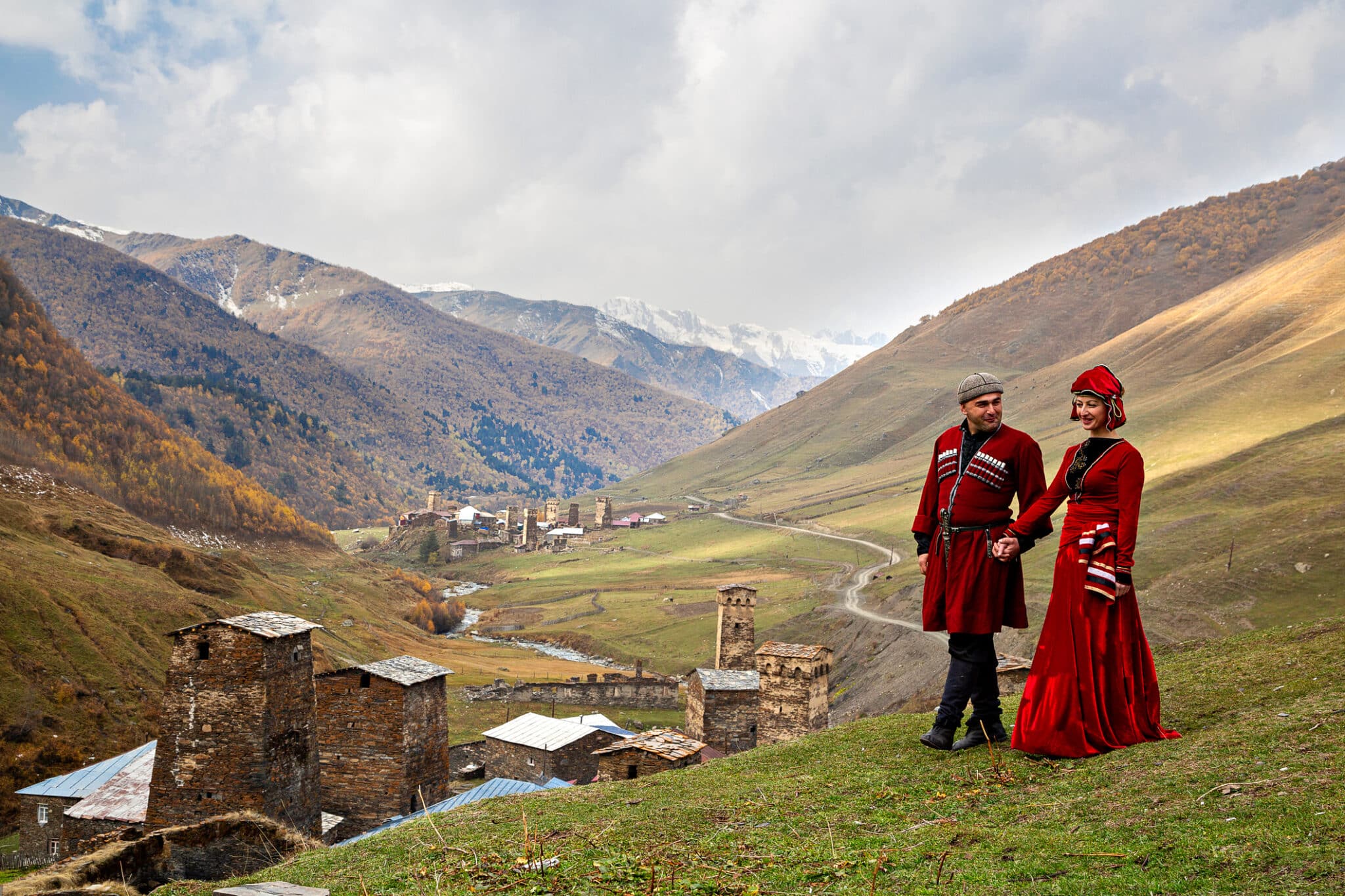
Georgia: A GeoHistory Study Guide
What Georgia might lack in size it makes up for in personality. Over the millennia, the nation we now call Georgia has been part of…
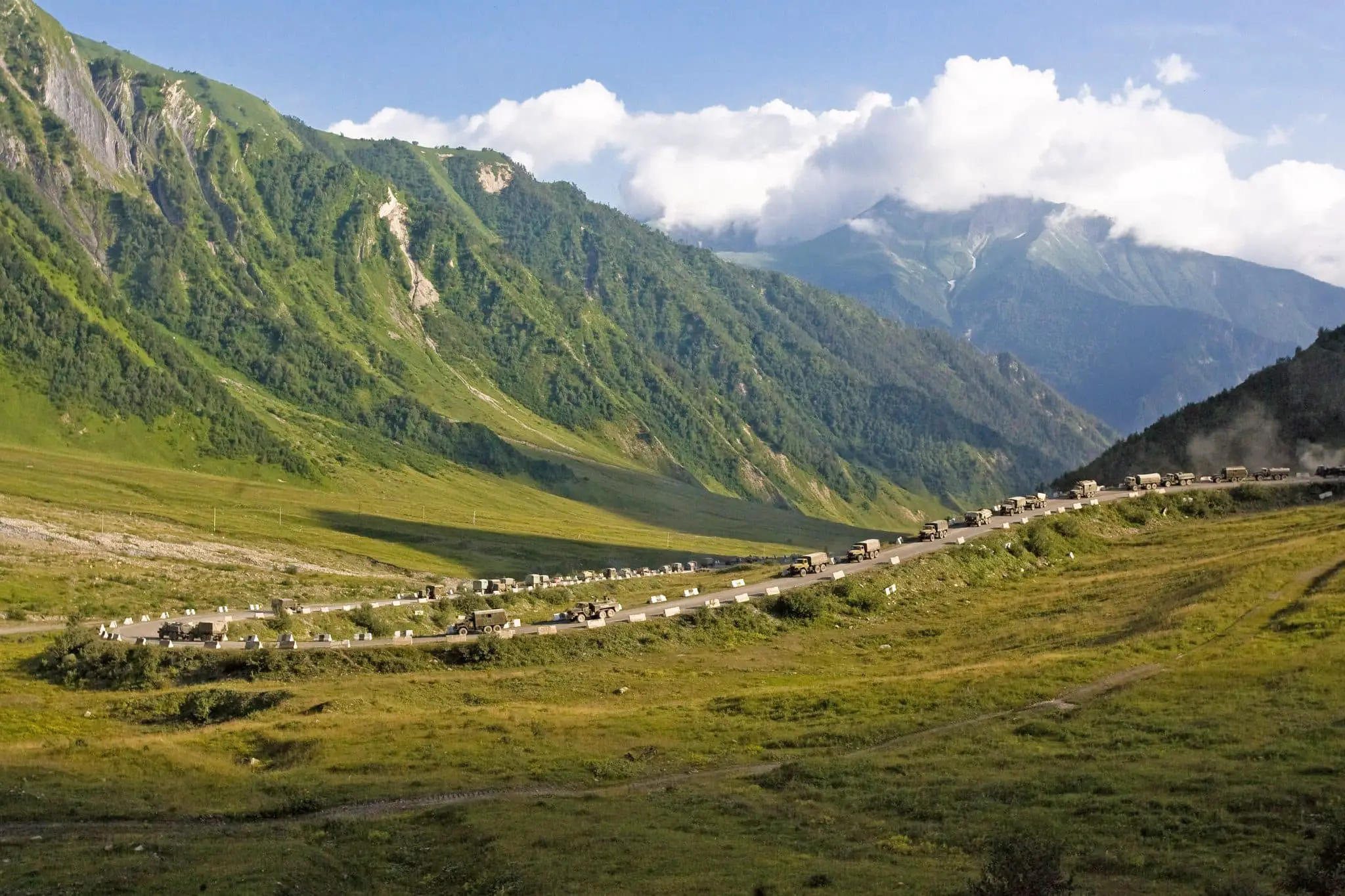
South Ossetia: Old Territory, New Problems
South Ossetia is one of the world’s newest independent states according to Russia, Nicaragua, Venezuela, and the microstates of Tuvalu and Nauru. According to all…

Tbilisi: The Immortal City
These days, a visitor to Tbilisi might be struck by the calm, southern European atmosphere that pervades this hilly capital. The old city of Tbilisi,…

Georgia: New State, Deep Roots
The Republic of Georgia, a small nation in the South Caucasus, covers territory which has seen the rise and fall of many empires and kingdoms…

Abkhazia: Grandeur to Ruin… and Back Again?
Abkhazia: Grandeur to Ruin… and Back Again? With its precipitous mountains, subtropical climate, and pristine beaches, one would expect Abkhazia to be the Black Sea…


